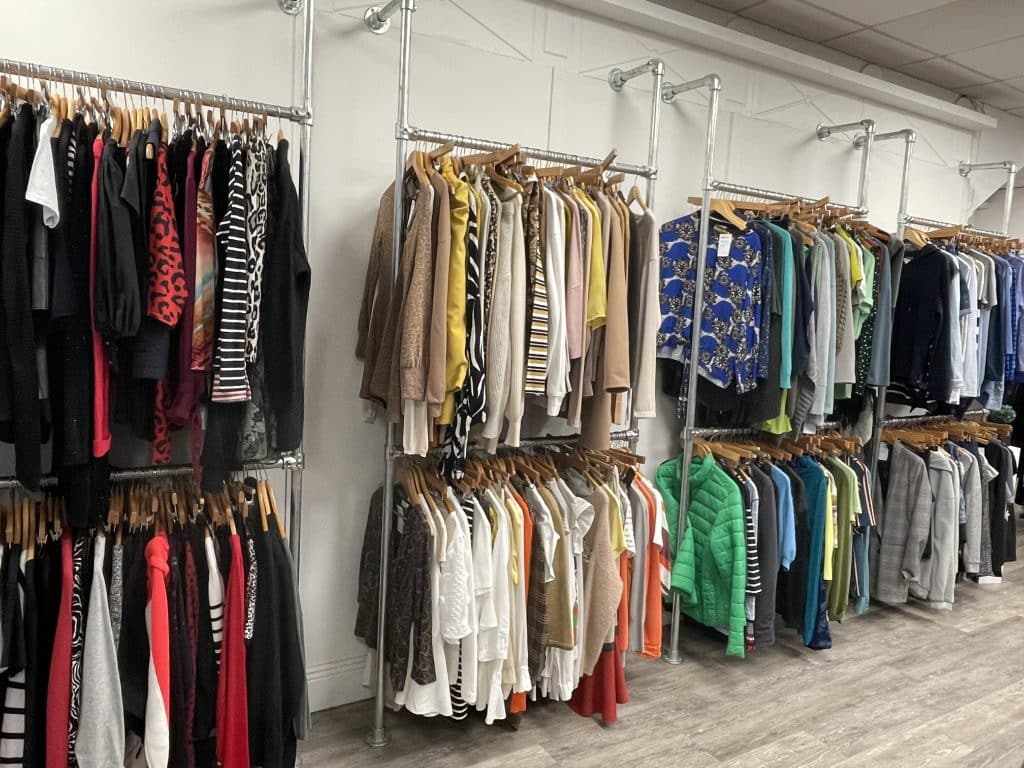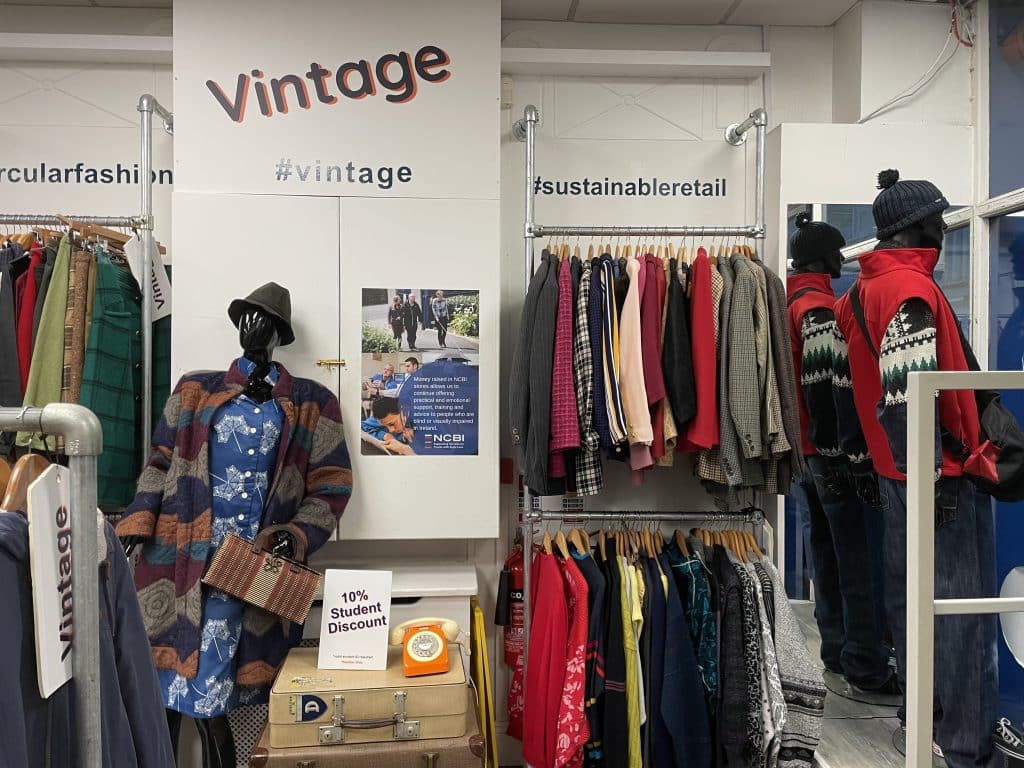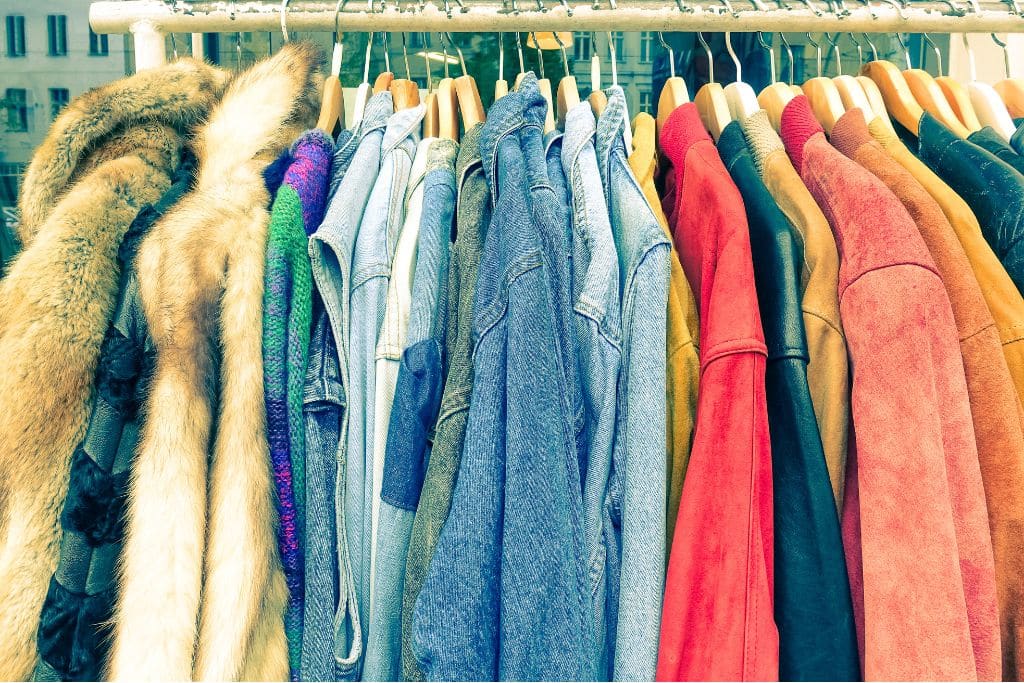In a world dominated by fast fashion’s harmful practices, a promising alternative is emerging from the racks of second-hand shops. These treasure troves of pre-loved clothing are not only a sustainable choice but are also reshaping the way we think about fashion. Earth.Org sat down with Susan Flaherty, owner of a thriving second-hand charity shop in Galway, Ireland, to discuss the growing appeal of sustainable style and the positive impact it can have on our planet.
—
Backstage, in a little room beyond the point of what customers can see in the Vision Ireland charity shop in Galway City, Susan Flaherty and her team of volunteers are sorting and steaming clothes and chatting away happily. It is 11am on a Thursday in October, and the room is piled high with bags full of donations and rails of clothes, all waiting to be priced up and sold.
Frontstage, the store is bustling with customers of all ages. The vintage section – which boasts authentic Levi jeans, 1980s puffer vests and 1990s jumpsuits – attracts a few college-aged students. A group of older women scrutinise a rail of blouses while a man checks out winter jumpers at the back of the shop.
Susan Flaherty is the manager of Galway’s Vision Ireland charity shop. With over 13 years of retail experience and being an avid second-hand shopper, she is excited about the future of second-hand fashion and wants more people to be aware of the offerings available.
“Second-hand shops have really moved on compared to years ago,” Flaherty told Earth.Org. “It’s not just anything and everything for sale. The standards are higher, and the clothes’ quality is better than in the past.”
In our environmentally-conscious society, charity shops around the country report increased footfall.

According to a recent survey from Vision Ireland, 20% of respondents visit a charity shop at least once per month. While 70% of respondents shop second-hand for the bargains available, 36% said they enjoy the sustainability benefits that come with shopping second-hand.
Unfortunately, many of us have misconceptions about second-hand clothes and need guidance on how to shop sustainably. But the assumption that the selection of second-hand clothes available is limited, of poor quality or outdated couldn’t be further from the truth.
“Don’t underestimate [second-hand shopping] it’s come a long way,” said Flaherty. “The quality and the price are there. And when you consider you’re helping a charity along with the sustainability factor, it’s a win-win.”
Why Does Sustainable Fashion Matter?
The second-hand retail market is booming and provides a sustainable and affordable alternative to new fast fashion. However, fast fashion companies remain popular, despite increased public awareness of the environmental issues associated with fast fashion.
Advertising campaigns from big brands lure us to their wares, and the enjoyment we get from buying cheap fast fashion, even to the detriment of our wallets and our planet, keeps us trapped.
Fast fashion’s negative impacts are well-known.
Fast fashion is responsible for nearly 10% of global carbon emissions – that is more than the total emissions coming from international flights and the maritime industry combined. Numerous high-profile tragedies have highlighted worker exploitation in the industry.
You might also like: Fast Fashion: The Danger of Sweatshops
Meanwhile, with the effects of the climate crisis now arriving on our doorstep, we must escape the trap of fast fashion. And if you think shopping sustainably means breaking the bank on bespoke pieces, this could not be further from the truth.
“We have options on the lower and higher end,” explained Flaherty. “And for students, we offer a 10% discount with a valid ID. So, it’s definitely accessible to everyone.”

Strict on Quality – Second-Hand Clothes Are No Second-Rate Option
Quality checking all donations before they get to the rails is key to Vision Ireland’s success.
“We get a mix of donations and vintage deadstock that we buy ourselves,” said Flaherty. “I’m strict on what goes out – if I wouldn’t wear the item myself, it doesn’t go on the shop floor.”
It is this approach that has helped Vision Ireland achieve success with a wide consumer base. By ensuring only first-rate clothes hit the shop floor, charity shops like Vision Ireland’s Galway branch can provide a wide range of high-quality clothes for their shoppers.
Flaherty also explained that people are turning to second-hand to build a unique wardrobe – and the second-hand selection rivals high-street offerings.
Given the current cost-of-living crisis, investing in quality pieces that will last you for years and building a second-hand capsule wardrobe is becoming more appealing.
“We offer a broad range of clothing,” she said. “We have speciality items like men’s suits and debs dresses, as well as the basics like blouses, skirts, tracksuit bottoms and trousers. And you can use these items in different ways, like making a capsule wardrobe or getting ready for a special occasion.”
Second-Hand Shopping: A Sustainable Alternative to Fast Fashion
In recent years, there has been an undisputable change in mindset towards consuming more consciously, driven by awareness and concern about sustainability and overproduction of clothing.
One concern is that mainstream fast fashion brands “greenwash” – meaning they use misleading and false eco-friendly marketing tactics to improve their image, rather than engaging more seriously with sustainability.
You might also like: 5 Fast-Fashion Brands Called Out for Greenwashing
If you are interested in hunting for stand-out pieces that you will not find anywhere else, while also helping the environment by ignoring fast fashion, a simple search online will help you find the best second-hand shops in your area. For newbies, Flaherty recommends seeking out vintage pieces.
“One of my biggest tips would be to look out for oversized labels and to see where the item was made,” she said. “Take America, for example; you don’t see ‘made in America’ labels on new clothes anymore, so you can be sure you’re getting a true, vintage piece when that’s marked on the tag”.
Clothes from eras gone by represent a different attitude toward fashion. Garments were made with a lifetime of wear in mind, and this is still visible today.
“Some of the best finds are clothes from countries that no longer exist,” said Flaherty. “For example, if you see ‘made in Yugoslavia’ on the label, you know you’re getting a real vintage one-off piece.”
The misconception that second-hand shopping is limiting couldn’t be further from the truth. With options ranging from authentic Y2K pieces to this season’s hottest trends, charity shops are an easy and affordable way to dress in a way that works for you.
You might also like: Explainer: What Is Slow Fashion and How Can You Join the Movement?


















